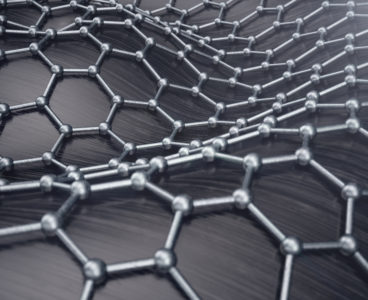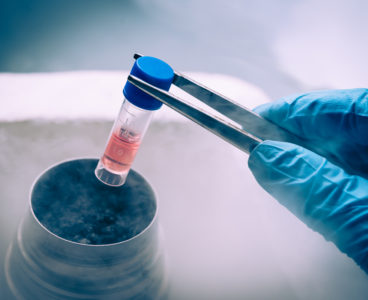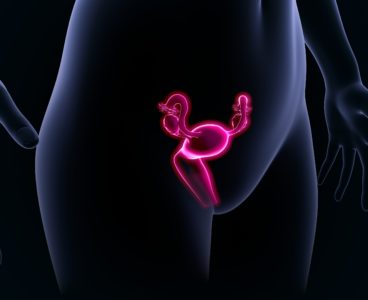A computer science research team at Dartmouth College has produced a smart fabric that can help athletes and physical therapy patients correct arm angles to optimize performance, reduce injury and accelerate recovery. The proposed fabric-sensing system is a flexible, motion-capture textile that monitors joint rotation. The wearable is lightweight, low-cost, washable and comfortable, making it…
Precision Sensor Delves Deep into Fingerprints
A fingerprint can serve as identification to access locked doors and more, but current scanners can be duped with fake or even similar fingerprints. That may change soon, thanks to a collaborative research team based in Japan. The group has developed a new proximity capacitance imaging sensor that has such high sensitivity and resolution, a…
Threads Can Detect Gases When Woven into Clothing
Tufts University engineers have developed a novel fabrication method to create dyed threads that change color when they detect a variety of gases. The researchers demonstrated that the threads can be read visually, or even more precisely by use of a smartphone camera, to detect changes of color due to analytes as low as 50…
Graphene Oxide Technology Provides Alternative to Biopsy
A prototype wearable device, tested in animal models, can continuously collect live cancer cells directly from a patient’s blood. Developed by a team of engineers and doctors at the University of Michigan, it could help doctors diagnose and treat cancer more effectively. “Nobody wants to have a biopsy. If we could get enough cancer cells…
Innovative Polymer Mixture Creates Ultra-sensitive Heat Sensor
Scientists at the Laboratory of Organic Electronics at Linköping University have developed an ultra-sensitive heat sensor that is flexible, transparent and printable. The results have potential for a wide range of applications—from wound healing and electronic skin to smart buildings. The ultra-sensitive heat sensor is based on the fact that certain materials are thermoelectric. The…
Tiny Sensors Have Big Potential for Energy
The electrical energy from batteries powers not only the ignition system that turns the engine and moves electric vehicles but also powers almost every sensing feature of today’s automobiles. Electricity turns on the car headlights for night travel, rolls the windows up and down, senses numerous actions within the car to keep drivers aware and…
Sensor Tracks Brain Chemical Gone Rogue Following Neurotrauma
Your chances of getting a nasty migraine increase following a spinal cord injury, thanks to a chemical messenger in the brain that spikes to toxic levels, past studies have suggested. For treatment to get any better, researchers need to catch that split-second spike in action and closely follow its path of destruction. Purdue University engineers…
Graphene Sensors Detect Ultralow Concentrations of NO2
The National Physical Laboratory has, as part of an international research collaboration, discovered a novel technique to monitor extremely low concentrations of NO2 in complex environments, using epitaxial sensors containing the “wonder material” graphene. The research, as published in ACS Sensors, was led by an international collaboration of scientists from Linköping University, Chalmers University of…
Innovative Cellulose-based Material Embodies Three Sensors in One
Cellulose soaked in a carefully designed polymer mixture acts as a sensor to measure pressure, temperature and humidity at the same time. The measurements are completely independent of each other. The ability to measure pressure, temperature and humidity is important in many applications, such as monitoring patients at home, robotics, electronic skin, functional textiles, surveillance…
Energy Monitor Senses Electrical Failures Before They Happen
A new system devised by researchers at MIT can monitor the behavior of all electric devices within a building, ship, or factory, determining which ones are in use at any given time and whether any are showing signs of an imminent failure. When tested on a Coast Guard cutter, the system pinpointed a motor with…
Need to Analyze Data? Ask ‘Dave’
Professor Andreas Schütze and his team of experts in measurement and sensor technology at Saarland University have released a free data processing tool called simply “Dave”—a MATLAB toolbox that allows rapid evaluation of signals, pattern recognition and data visualization when processing huge datasets. The free software enables very large volumes of data, such as those…
Sensor System Improves High-temperature Humidity Measurements
A new sensor system developed in Saarbrücken, Germany can not only carefully control drying processes in industrial ovens, but can deliver reliable air humidity measurements even at high temperatures and in the presence of other background vapors. Professor Andreas Schütze, project manager Tilman Sauerwald and their research team at Saarland University have developed with partner…
Minuscule Magnetic Fields Measured with Quantum Sensing Method
A new way of measuring atomic-scale magnetic fields with great precision, not only up and down but sideways as well, has been developed by researchers at MIT. The new tool could be useful in applications as diverse as mapping the electrical impulses inside a firing neuron, characterizing new magnetic materials, and probing exotic quantum physical…
Researchers Produce Transparent, Self-healing Electronic Skin
National University of Singapore scientists have taken inspiration from underwater invertebrates like jellyfish to create an electronic skin with similar functionality. Just like a jellyfish, the electronic skin is transparent, stretchable, touch-sensitive, and self-healing in aquatic environments. It can be used in everything from water-resistant touchscreens to aquatic soft robots. The team, led by NUS…
Hidden Leukemic Stem Cells Isolated by Genetically Encoded Sensor
All stem cells can multiply, proliferate and differentiate. Because of these qualities, leukemic stem cells are the most malignant of all leukemic cells. Understanding how leukemic stem cells are regulated has become an important area of cancer research. A team of Tel Aviv University researchers have now devised a novel biosensor that can isolate and…
Space Radiation Detector Investigates Fake Masterpieces
Technology originally developed for CERN’s Large Hadron Collider and then flown in space by ESA is now being used to analyze historic artworks, helping to detect forgeries. “The art market is a jungle—some say that around 50 percent of art pieces and paintings are either fakes or are incorrectly attributed,” explains Josef Uher, chief technology…
Mini Magnetic Sensors Could Operate Without Power Supply
Scientists of the Department of Physics at the University of Hamburg, Germany, detected the magnetic states of atoms on a surface using only heat. The respective study is published in a recent volume of Science. A magnetic needle heated by a laser beam was placed in close proximity to a magnetic surface with a gap…
Revolutionary Wireless Sensors Gently Monitor NICU Babies
An interdisciplinary Northwestern University team has developed a pair of soft, flexible wireless body sensors that replace the tangle of wire-based sensors that currently monitor babies in hospitals’ neonatal intensive care units (NICU) and pose a barrier to parent-baby cuddling and physical bonding. The team recently completed a collection of first human studies on premature…
Diamond Tips Advance Nanoscale Sensing
Commercially-available diamond tips used in atomic force microscopy (AFM) could help make quantum nanoscale sensing cost-effective and practical, A*STAR researchers have found. The idea of using ‘color centers’, optically-active atomic defects in diamond, as a probe for taking highly sensitive nanoscale measurements of quantities such as elecromagnetic field, temperature, or strain is well known. In…
Sensors Offers Real-Time Diagnosis of Reproductive Health Issues
Researchers have developed new robotic sensor technology that has the capability to diagnose women’s reproductive health problems in real-time. The technology, developed by researchers at Imperial College London and The University of Hong Kong, can be used to measure hormones that affect fertility, sexual development and menstruation more quickly and cheaply than current methods. The…
Study Finds Wearable Devices Not Effective for Forecasting Stress Fractures
Whether you are a professional athlete or an amateur runner, there may be no more debilitating and frustrating injury than a stress fracture. Stress fractures generally begin with persistent and irritating pain in the foot or lower leg that gets more intense and possibly swollen as the athlete continues to train. These injuries— microcracks in…
Lasers, Graphene Form Tailor-Made Marine Sensors
A flexible, lightweight and robust salinity sensor that can be attached to aquatic animals for long-term monitoring of their habitat has been developed by a multidisciplinary team at KAUST. The team created a sensor that accurately records salinity even after long-term submersion. The sensor can form the basis of a marine animal monitoring device that…
Stretchable Fiber Used for Energy Harvesting and Strain Sensing
Fiber-based electronics are expected to play a vital role in next-generation wearable electronics. Woven into textiles, they can provide higher durability, comfort, and integrated multi-functionality. A KAIST team has developed a stretchable multi-functional fiber (SMF) that can harvest energy and detect strain, which can be applied to future wearable electronics. With wearable electronics, health and…
Optical Fiber Sensors Protected by ‘Jacket’ Coating
Optical fibers enable the Internet, and they are practically everywhere: underground and beneath the oceans. Fibers can do more than just carry information: they are also fantastic sensors. Hair-thin optical fibers support measurements over hundreds of km, may be embedded in almost any structure, operate in hazardous environments and withstand electro-magnetic interference. Recently a major…
Ingestible Monitoring Pill Swells to Size of Ping Pong Ball
MIT engineers have designed an ingestible, Jell-O-like pill that, upon reaching the stomach, quickly swells to the size of a soft, squishy ping-pong ball big enough to stay in the stomach for an extended period of time. The inflatable pill is embedded with a sensor that continuously tracks the stomach’s temperature for up to 30…











